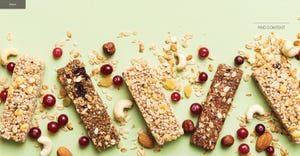Consumers welcome the idea of added-sugar warning labels on restaurant menus, per a new study.

A new study found 80% of people support adding warning labels for items with high amounts of added sugar on restaurant menus (Prev Med. 2022. 160:107090).
Americans love sugar. In fact, U.S. adults consume about 60 pounds of sugar each year and about three times the daily recommended amount of sugar each day, according to the American Heart Association (AHA). Children exceed that amount, consuming over 65 pounds of sugar every year, per AHA.
Restaurants, according to data from the National Health and Nutrition Examination Survey (NHANES), account for about 16% of Americans’ intake of added sugars—10% from quick-service restaurants (QSRs) and 6% from full-service restaurants (FSRs).
Excessive intake of added sugars can lead to serious health problems such as obesity, type 2 diabetes and heart disease, leading regulators to seek out policy options that could slow consumption of sugar. Some U.S. cities, for example, have implemented excise taxes on sugar-sweetened drinks, the leading source of added sugar intake in American’s diets, with the goal of curbing sugar consumption.
The present study, published in Preventive Medicine, set out to test the waters of added-sugar warning labels on restaurant menus.
For the online study, 1,327 adults across the U.S. were shown either a control label, an icon-only added sugar warning label, or an added sugar warning icon combined text. Six variations of icons were tested and three variations of text were tested, including "high in added sugars," "high sugars" and "sugar warning." Participants rated the icon they were shown based on the icon’s perceived message effectiveness. Participants were also asked to classify menu items by their added-sugar content.�
The icons were designed by the study team to resemble stop, yield and caution traffic signs and contain either an exclamation mark or an exclamation mark with a spoon.
Results showed the icon-only and icon-plus-text labels were perceived as more effective than the control label, though there were no significant differences when comparing icon-only to icon-plus-text labels.
Researchers also found that the icon-only and icon-plus-text groups each correctly classified 71% of menu items by added-sugar content versus 56% in the control group.
“This is the first study to our knowledge to design and test added-sugar warning labels for restaurant menus,” researchers wrote. “Compared to a control label, both the icon-only and the icon-plus-text added-sugar warning labels were perceived as more effective at potentially reducing consumption of menu items high in added sugar and increased knowledge of items' added-sugar content.”
The results also found that the vast majority of study participants (80%) supported using added-sugar warning labels on restaurant menus.
“Menu warning labels may be a promising strategy for reducing added-sugar consumption from restaurants, but research on behavioral effects in real-world settings is needed,” researchers wrote.
Rachel Adams joined Informa’s Health & Nutrition Network in 2013. Her career in the natural products industry started with a food and beverage focus before transitioning into her role as managing editor of Natural Products INSIDER, where she covered the dietary supplement industry. Adams left Informa Markets in 2019.
About the Author(s)
You May Also Like






